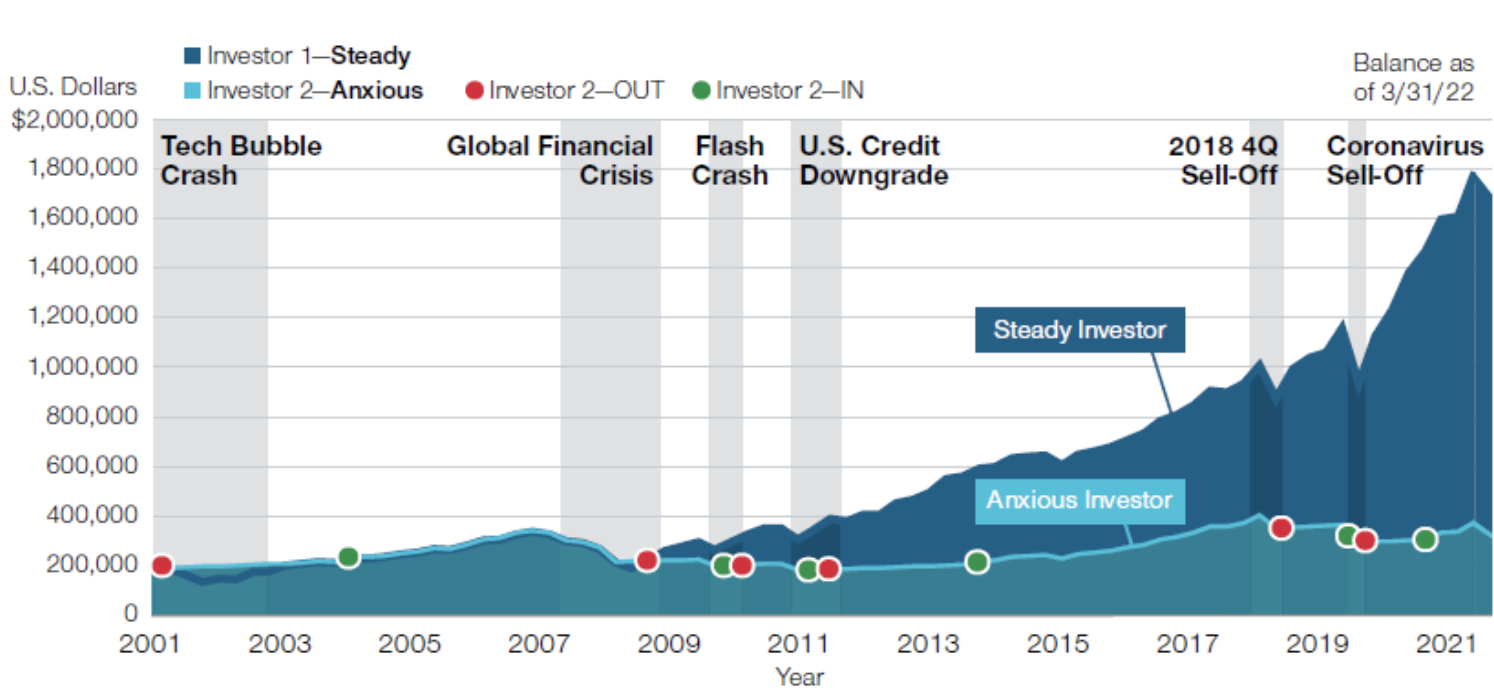The war in Ukraine, ongoing Covid concerns, market volatility and the threat of a recession are enough to make even seasoned investors anxious – particularly about how much of their portfolio is in stocks. Amid all the stress, including about current and prospective events, the stability of fixed-income securities or even cash can start to look more attractive than equities. Consider working with a financial advisor as you build a long-term investing plan and asset allocation.
What Is Market Timing?
Market timing, which is the opposite of a buy-and-hold strategy, is buying or selling because you expect a specific change in the price of a stock or value of an index. If you think the stock will go up you might plan a sale. If you think the stock will go down, you might sell immediately. By contrast if you think the stock will go down you might plan a buy order, while if you expect it to go up you might buy immediately. It is a form of active management.
In all cases, market timing is based on price volatility. While issues such as asset fundamentals and financial planning might play a role in your decision making, they are simply elements of a decision that revolves around anticipated changes to the price. The goal of market timing is to turn these predictions into a profit. By timing your purchases and sales you can – or hope you can – move before the market does and collect the profits.
The Awful Track Record of Market Timing
Numerous research studies by disinterested parties demonstrate the failures of market timing. To pull just a few examples:
- A study by Merrill Lynch found that model portfolios over a 30-year period could underperform by nearly half their value through market timing.
- Charles Schwab tells us that their “research shows that the cost of waiting for the perfect moment to invest exceeds the benefit of even perfect timing. And because timing the market perfectly is, well, about as likely as winning the lottery, the best strategy for most of us mere mortal investors is not to try to market-time at all.”
- A survey by Putnam Investments found that market timers who miss just 10 days in the market could lose up to half the value of their portfolio. Their model found that getting it wrong by no more than a month was the difference between $6,873 in returns and $30,711.
Why Market Timing Usually Fails
There are several reasons market timing usually fails. One reason is that very few can consistently predict short-term market movements. That goes for spotting a decline before it starts as well as knowing when the market will rebound. The decision to reduce stock exposure, moving these assets into money market investments or cash, not only means anticipating when to exit the market, but choosing when to reenter the market as well, Judity Ward and Roger Young of T. Rowe Price wrote in a recent article. In other words, it requires two acts of successful market timing.
Consider the illustration from T. Rowe Price below.

This chart tracks two hypothetical investors, each one of which deposited $2,000 per month into their investment accounts. One investor maintained a steady asset allocation while the other, who let anxiety influence investing decisions, jumped in and out of 3-month Treasurys as cash equivalents whenever stocks dropped 10% or more in a quarter. Obviously, over time the “steady” investor did vastly better than the “anxious” investor.
Another reason market timing exacts such a high price on investors is that over time stocks provide more reliable capital appreciation than bonds. So dumping them because they have lost value or because you expect them to lose value forecloses the possibility of profiting from that capital appreciation.
Alternatives to Market Timing
What to do instead of attempting to time the market depends on what your main concerns are.
- If your main concern is having enough cash to live on then it makes sense to build up enough savings to cover two years. This is especially applicable to those nearing retirement or already retired.
- If your main concern is getting protection against a major downturn in the stock market, then maintaining or modestly boosting your allocation of bonds makes sense.
- If your main concern is missing out on a market rebound, consider investing a little at a time by gradually purchasing stocks. You don’t have to time it perfectly. Research by the T. Rowe Price investment team shows that rebalancing into stocks during a downturn historically improved results over the subsequent year, even if that adjustment was made a few months before or after the official market bottom.
Bottom Line

It can be tempting to fantasize about being just one perfectly timed pair of trades away from a seven-figure net worth. The catch is that “perfectly timed” part. Fact is, in times of market volatility, it’s impossible to know when it may end. Investors who feel a strategy change is in order could consider gradual adjustments. They could also wait until the volatility subsides to make wholesale shifts to their strategy. What you shouldn’t do is fall for the siren song of market timing. You could spend thousands on hot-tip newsletters or financial web site subscriptions, each promising sure-fire tips for market timing. However, the only people making any money off those tips are the people who sell them.
Tips on Investing
- Healthcare dangers, foreign wars and a looming recession can tempt you to change your asset allocation suddenly and dramatically. But there’s a big risk in that. A financial advisor can help you approach investing decisions rationally – rather than emotionally. Finding a qualified financial advisor doesn’t have to be hard. SmartAsset’s free tool matches you with up to three financial advisors who serve your area, and you can interview your advisor matches at no cost to decide which one is right for you. If you’re ready to find an advisor who can help you achieve your financial goals, get started now.
- Determine how your money will grow over time with this free investment calculator from SmartAsset.
Don’t miss out on news that could impact your finances. Get news and tips to make smarter financial decisions with SmartAsset’s semi-weekly email. It’s 100% free and you can unsubscribe at any time. Sign up today.
For important disclosures regarding SmartAsset, please click here.
Photo credit: ©iStock.com/Altayb, ©T. RowePrice, ©iStock.com/JuSun
